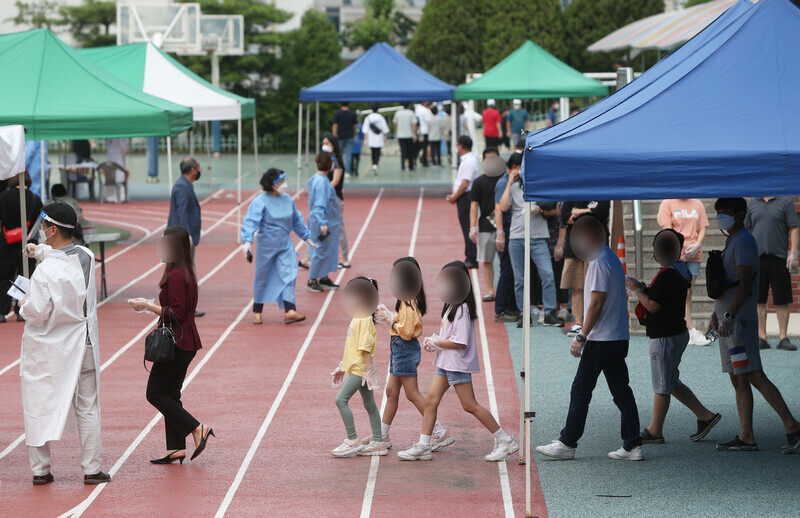hankyoreh
Links to other country sites 다른 나라 사이트 링크
S. Korea to roll out vaccines for pregnant people, those aged 12 to 17

The South Korean government plans to begin administering COVID-19 vaccinations in the fourth quarter to around 2.76 million children aged 12 to 17 and 270,000 pregnant people.
It also aims to begin administering booster shots of the vaccines, starting with high-risk groups.
But its policies are expected to ignite controversy, with many experts insisting on adopting a more cautious approach and waiting to observe the situation overseas before administering the vaccines to children.
On Monday, the COVID-19 vaccination response team announced, “Based on discussions at a vaccination expert committee meeting on [Wednesday], a recommendation was made to extend vaccinations to pregnant women and children aged 12 to 17, who had previously been excluded from inoculation, and to administer booster shorts beginning six months after the completion of basic vaccination [the single dose of the Janssen vaccine or the second dose of other vaccines].”
Based on the committee’s recommendation, the response team is to formulate plans for the vaccination of children and pregnant people and administration of booster shots, with details to be announced during September.
The vaccinations in question appear likely to use mRNA vaccines. For children, the first vaccine to be used is likely to be the one developed by Pfizer, as it is the only vaccine currently approved by the South Korean Ministry of Food and Drug Safety (MFDS) for use in those aged 12 to 17.
A request by Moderna on July 7 to lower the minimum age for administration of its vaccine from 18 to 12 years is currently being reviewed by the MFDS.
The primary targets for booster shots are expected to be the same populations prioritized for basic vaccine administration: long-term care hospital and elderly care facility patients and staff, medical staff at COVID-19 treatment hospitals and adults aged 75 and up.
“The same priorities as in the first half of the year are to be applied [for administration of booster shots],” said Jung Eun-kyeong, chair of the response team and commissioner of the Korea Disease Control and Prevention Agency.
“In addition, we also need to administer booster shots more quickly to certain people with chronic conditions and immunocompromised people, so we will be examining plans for priority administration,” she added.
The response team also said Monday that there was no need for a wait time between COVID-19 vaccination and the administration of vaccines for the flu or other conditions.
Early in the COVID-19 inoculation campaign, a wait of at least 14 days was recommended amid a lack of relevant data. But with more information available now on COVID-19 vaccine safety, no scientific basis was found for requiring a wait time between different vaccines.
In a meeting of Blue House senior secretaries and aides the same day, President Moon Jae-in said, “Once the vaccination age has been lowered to 12 and additional vaccinations are completed for those who have not been vaccinated yet, we will have a vaccination rate of close to 80%, which means we can achieve an even higher rate of vaccination than in other countries.”
Jung Ki-seok, a pulmonologist at Hallym University Sacred Heart Hospital, said, “Since teenagers are at a very low risk [of severe symptoms from] infection with COVID-19, we should make a cautious decision about vaccination after observing vaccinations overseas a bit more and minimizing any concerns about vaccine safety.”
By Choi Ha-yan, staff reporter
Please direct comments or questions to [english@hani.co.kr]

Editorial・opinion
![[Guest essay] Preventing Korean Peninsula from becoming front line of new cold war [Guest essay] Preventing Korean Peninsula from becoming front line of new cold war](https://flexible.img.hani.co.kr/flexible/normal/500/300/imgdb/original/2024/0507/7217150679227807.jpg) [Guest essay] Preventing Korean Peninsula from becoming front line of new cold war
[Guest essay] Preventing Korean Peninsula from becoming front line of new cold war![[Column] The state is back — but is it in business? [Column] The state is back — but is it in business?](https://flexible.img.hani.co.kr/flexible/normal/500/300/imgdb/original/2024/0506/8217149564092725.jpg) [Column] The state is back — but is it in business?
[Column] The state is back — but is it in business?- [Column] Life on our Trisolaris
- [Editorial] Penalties for airing allegations against Korea’s first lady endanger free press
- [Editorial] Yoon must halt procurement of SM-3 interceptor missiles
- [Guest essay] Maybe Korea’s rapid population decline is an opportunity, not a crisis
- [Column] Can Yoon steer diplomacy with Russia, China back on track?
- [Column] Season 2 of special prosecutor probe may be coming to Korea soon
- [Column] Park Geun-hye déjà vu in Yoon Suk-yeol
- [Editorial] New weight of N. Korea’s nuclear threats makes dialogue all the more urgent
Most viewed articles
- 1Yoon’s broken-compass diplomacy is steering Korea into serving US, Japanese interests
- 2[Guest essay] Preventing Korean Peninsula from becoming front line of new cold war
- 3[Column] Why Korea’s hard right is fated to lose
- 460% of young Koreans see no need to have kids after marriage
- 5S. Korean first lady likely to face questioning by prosecutors over Dior handbag scandal
- 6[Guest essay] Maybe Korea’s rapid population decline is an opportunity, not a crisis
- 7[Column] The state is back — but is it in business?
- 8After 2 years in office, Yoon’s promises of fairness, common sense ring hollow
- 9[Reporter’s notebook] In Min’s world, she’s the artist — and NewJeans is her art
- 10[Editorial] Penalties for airing allegations against Korea’s first lady endanger free press